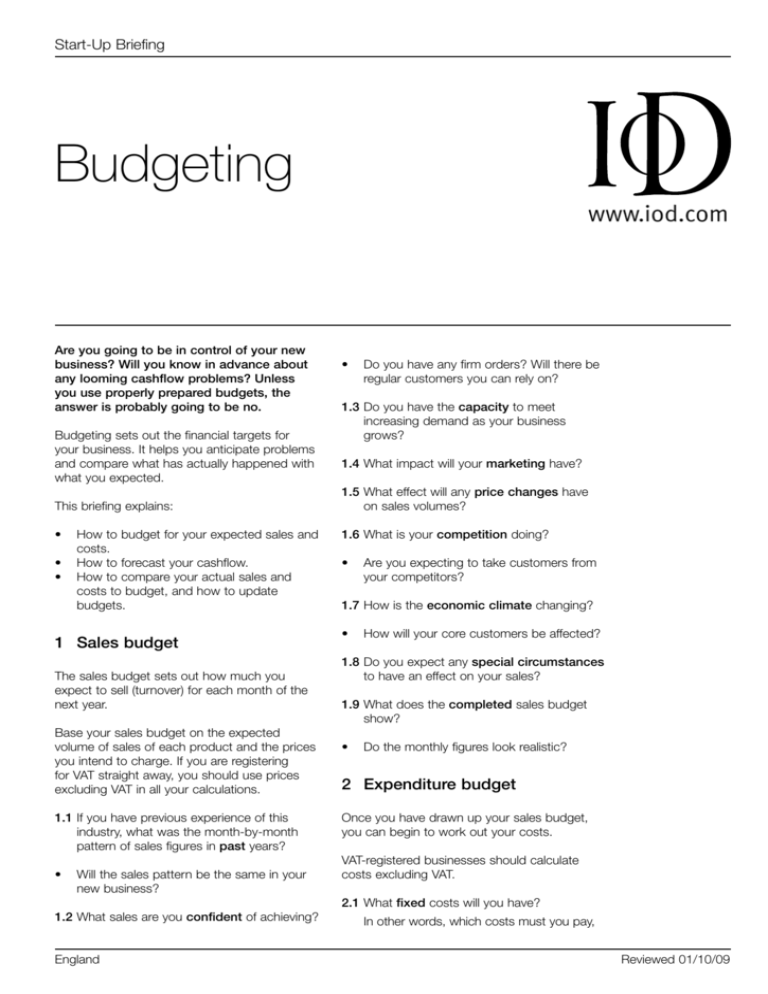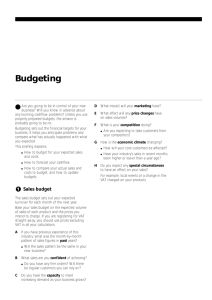
Start-Up Briefing
Budgeting
Are you going to be in control of your new
business? Will you know in advance about
any looming cashflow problems? Unless
you use properly prepared budgets, the
answer is probably going to be no.
Budgeting sets out the financial targets for
your business. It helps you anticipate problems
and compare what has actually happened with
what you expected.
This briefing explains:
• How to budget for your expected sales and
costs.
• How to forecast your cashflow.
• How to compare your actual sales and
costs to budget, and how to update
budgets.
1 Sales budget
The sales budget sets out how much you
expect to sell (turnover) for each month of the
next year.
Base your sales budget on the expected
volume of sales of each product and the prices
you intend to charge. If you are registering
for VAT straight away, you should use prices
excluding VAT in all your calculations.
1.1If you have previous experience of this
industry, what was the month-by-month
pattern of sales figures in past years?
• Will the sales pattern be the same in your
new business?
• Do you have any firm orders? Will there be
regular customers you can rely on?
1.3Do you have the capacity to meet
increasing demand as your business
grows?
1.4What impact will your marketing have?
1.5What effect will any price changes have
on sales volumes?
1.6What is your competition doing?
• Are you expecting to take customers from
your competitors?
1.7How is the economic climate changing?
• How will your core customers be affected?
1.8Do you expect any special circumstances
to have an effect on your sales?
1.9What does the completed sales budget
show?
• Do the monthly figures look realistic?
2 Expenditure budget
Once you have drawn up your sales budget,
you can begin to work out your costs.
VAT-registered businesses should calculate
costs excluding VAT.
2.1What fixed costs will you have?
1.2What sales are you confident of achieving?
England
In other words, which costs must you pay,
Reviewed 01/10/09
Start-Up Briefing
2
no matter how much you sell?
•
•
•
•
•
•
•
•
•
Rent, rates and insurance.
Phones, Internet and computer costs.
Interest charges.
Maintenance and repairs.
Electricity, gas and water rates.
Staff wages and expenses.
Advertising.
Administration (eg accountants’ fees).
Depreciation of equipment, furniture and
other fixed assets.
You will need to know what your fixed costs
are, so that you can calculate what volume
of sales you need to break even.
£ breakeven = £ £ fixed costs x 100
% gross margin
In other words, if your gross margin is 25
per cent, sales must be four times as large
as fixed costs, just to break even.
2.2What variable costs will you have? In other
Playing the percentages
Percentages can be more revealing than
figures in pounds and pence, especially if
you sell a range of products.
A What percentage of sales do you
expect for each product?
• You may want to concentrate your
efforts on important products you think
will represent a large proportion of your
sales or highest profit margins.
• Alternatively, products which make up
a small percentage of your sales may
provide an opportunity to sell more.
B How high will the percentage profit
margins be on different products?
• Which products will provide the best
profit margins?
• How will your prices compare with
competitors’ prices?
• Will the profit margin on each product
be high enough to cover its share of the
overheads?
C What percentage of your expected
turnover will your overhead costs
represent?
For example, what percentages will
be taken up by labour, premises and
administration? Could you cut costs in
any of these areas?
words, which costs will grow or diminish in
line with sales?
•
•
•
•
Raw materials.
Distribution.
Advertising.
Extra staff costs, for overtime or temps.
2.3Are any of these fixed or variable costs
likely to change?
The expenditure budget will be far more useful
if you separate out fixed and variable costs.
3 Cash budget
The cash budget (or cashflow forecast) uses
the information in the sales and expenditure
budgets to forecast the money going into and
out of your bank account each month.
3.1What is the timing of cash movements?
• When will the money from your forecast
sales actually arrive?
Should you allow for a percentage of bad
debts (sales which are never paid for)?
• When will you pay out for costs such as
salaries, equipment and raw materials?
• Some payments will have to be made in
advance (eg rent, rates and insurance)
or by monthly standing orders.
3.2What other money will you be receiving
and paying out?
• Finance, eg receiving grant payments or
repaying a loan.
• Any capital expenditure.
• Tax payments or rebates.
• VAT payments or receipts (if you are
registered for VAT).
3.3Using these figures, forecast your bank
balance at the end of each month.
4 Balance sheet projections
While you are working on budgets, calculate
the effect of meeting them on your assets and
liabilities.
4.1This will provide you with an internal check
on their consistency.
4.2It will provide you with management
information.
• For example, it will show how much you
are likely to be owed by customers at the
“
Using appropriate
accounting
software allows
firms to more
easily adjust
their budgets to
calculate the effects
of any change in
circumstances.
Clive Lewis,
Institute of
Chartered
Accountants in
England & Wales
”
Start-Up Briefing
end of the period, or how much you are
likely to owe suppliers and HM Revenue &
Customs for VAT and PAYE/NIC.
4.3It will provide financial information for
prospective backers.
• For example, your bankers will need
information on your prospective balance
sheet before they decide to lend to you.
4.4It will focus your mind on the need for
capital spending.
• It will show the impact of depreciation
on the balance sheet value of new cars,
equipment and other fixed assets.
Using budgeting software
Budgeting software makes it easier for
you to produce and update the budgets
and forecasts you will need to control your
business’ finances. It also makes budgeting
errors less likely, and looks good to
important outsiders such as banks.
Such software allows you to:
A Adjust your budgets quickly
• To ensure your figures are up to date
and realistic.
• To test what could happen if some of
your forecasted figures turn out to be
incorrect.
B Perform automatic calculations.
• To show how costs are changing in
relation to each other (eg labour costs
as a percentage of total fixed costs).
• To monitor the profitability of products.
C Use the automatic links between
budgets.
• To see how changes in the sales or cost
budgets will affect the cash budget.
For example, would you run into a
cashflow problem if sales were suddenly
lower or higher than forecast?
D Produce fully integrated forecasts of
your business’ financial performance.
• Budgeting software can draw on budget
figures to make the forecasts you need
for your profit and loss account, balance
sheet and cashflow statement.
3
5 Preventive measures
Drawing up a budget enables you to spot
problems before they happen.
5.1Are you in danger of underperforming?
• Does your business need to build up sales
as rapidly as possible?
• Will your forecast costs be too high?
Where is there scope for cutting back?
➨ For the budgeting
toolkit ‘Making
a Success of
your Business’
(£29.95 plus £2.95
postage and
packaging), call the
Chartered Institute
of Management
Accountants
(01865 474014).
5.2Does your cash budget show that you are
going to exceed your overdraft limit in any
month? How will you improve cashflow?
• Collect sales income faster.
• Delay payments to your suppliers.
Would this lose you discounts or damage
your relationships with them?
• Arrange extra finance.
• Delay new capital expenditure.
5.3Are you over-trading?
• The higher your sales, the more money you
will need to spend on supplies and other
costs — before being paid yourself.
• If the level of sales becomes too high, your
business may simply run out of cash.
• There is no point in capturing huge orders,
if you run out of cash and go bankrupt.
6 Actual sales
Your budget is only an educated guess about
the future. But once you have started trading,
comparing your actual monthly sales and costs
with the budget will let you know what is really
happening. Begin with sales.
6.1Was turnover lower than budget? Why?
• If prices or volumes were lower, why?
Are prices or volumes likely to be lower
than forecast in future months, too?
6.2If turnover was higher than budget, why?
• Were sales brought forward from future
months?
• Was the increase in sales caused by large
one-off orders?
6.3Were sales of any individual product lines
significantly different from forecast levels?
• Is one product becoming outdated?
• Is another product growing more popular?
• Do you need to focus your marketing or
production plans on different products?
“
Don’t be tempted
to be over
optimistic in setting
your budgets; you
will only be fooling
yourself in the
longer term as the
impacts on profit
and then cash
start to become
obvious.
Geoff Wightwick,
Baker Tilly
”
Start-Up Briefing
7 Actual costs
At the end of each month, check how your
actual costs compare with the budget forecast.
7.1Are they higher or lower overall?
7.2Which fixed costs varied?
Was this a one-off, or will the fixed costs
stay at these new levels?
For example, will you keep on extra staff?
4
• For example, suppose you have budgeted
for an overdraft of £2,000 at the end of
September, and £10,000 at the end of
October. But at the end of September, the
actual overdraft is £2,500.
If nothing else has changed in the October
budget, you should now budget for an
overdraft of £10,500 at the end of October,
£500 more than previously budgeted.
9 Keep up to date
7.3How should variable costs have differed
from budget?
9.1Your budgets should always represent
accurate and realistic targets.
• For example, consider a candle-maker with
budgeted sales of 800 candles, using £800
of wax (eg £1 per candle).
• This way, you will know what to expect.
You will be able to tell what has gone
according to plan, and foresee problems
and opportunities in time to take action.
If actual sales were 1,000 candles, the cost
of wax should be £200 more than forecast.
7.4How did variable costs differ from budget?
Expert
contributors
Thanks to Geoff
Wightwick (Baker
Tilly chartered
accountants, 0161
830 4000); Clive
Lewis (Insitute
of Chartered
Accountants in
England & Wales,
020 7920 8667;
www.icaew.com/
enterprise).
9.2If circumstances change, update your
budgets — so that next month you can tell
what else is different.
• If the candle-maker spent £1,100 on wax
for 1,000 candles, the business has spent
£100 more on wax than it should have.
Looking at it another way, the cost of wax
has risen by ten pence per candle to £1.10.
Why? Did the price of wax increase, or was
more wax wasted in production?
7.5Are any of the cost changes permanent or
do you expect costs to revert to normal?
8 Actual cash
8.1How does your month-end cash balance
compare with your forecast balance?
8.2What caused any differences?
• Was turnover different from budget?
• Were costs different from budget?
• Was the timing of cashflow different?
For example, did customers delay payment
longer than you had budgeted for?
8.3Change your future cash budget to reflect
any timing differences.
• For example, if sales were as expected,
but a large customer delayed payment, you
must increase the forecast incoming cash
for the month in which you now expect to
be paid.
8.4Keep changing your future cash budget to
reflect the actual cash balance.
Published by Atom Content Marketing Ltd, Albert House, 111 Victoria Street, Bristol, BS1 6AX
Tel: 0117 904 2224, http://atomcontentmarketing.co.uk
© Atom Content Marketing
Ltd 2009. ISSN 1469-0470.
All rights reserved. No
part of this publication
may be reproduced or
transmitted without the
written permission of the
publisher. This publication
is for general guidance
only. The publisher, expert
contributors and distributor
disclaim all liability for
any errors or omissions.
Consult your local business
support organisation or your
professional adviser for help
and advice.










